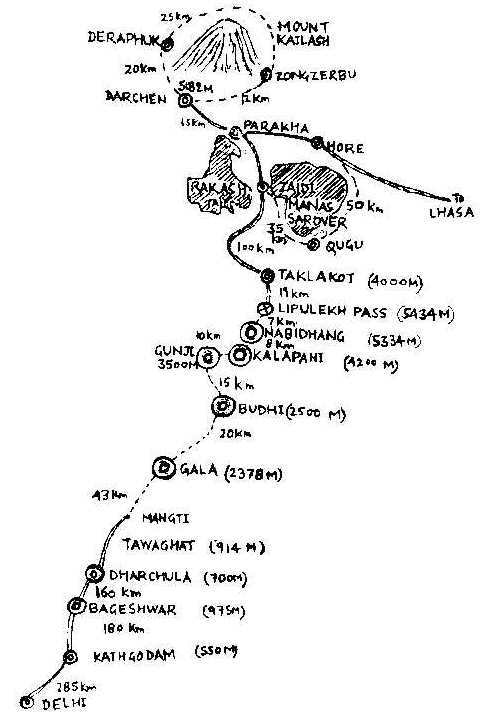| | ||
| |
|
|
|
|
Kailash, Manasarovar Yatra - A Sketch -R M Nair Normally there are 16 batches of 35 pilgrims every year. According to a time-table, the yatris are called to Delhi batch-wise. Officials brief them and they are put up at a hotel. On return after pilgrimage also they stay here, before they leave for home. Their first day in Delhi is for medical examination (second one), second day for payments and detailed briefings on the yatra and on the third day they can collect their visas and forex and set off. The yatris reach Kathgodam (280 km) by bus. The second night they spend at Bageshwar (180 km). The following night halts after each day's trek are Dharchula (160 km), Gala (43 km), Budhi (20 km), Gunji (15 km), Kalapani (10 km), Navidhang (8 km), reaching Lipulekh (7 km) on the 9th day but the 9th night halt is at Taklakot across the border (19 km). Trekking begins at Mangti, which lies between Dharchula and Gala. The Kumaon Mandal Vikas Nigam makes all arrangements for accommodation, food etc at all the halts from New Delhi to Lipulekh Pass. Pucca barracks and pre-fabricated fibreglass huts are provided. Satisfactory toilet facilities, power supply for limited duration with generators, mattresses and quilts/sleeping bags are available. Ponies and porters, if needed, should be booked at Mangti for upward journey to Lipulekh Pass and at Lipulekh Pass while returning. Ponies and porters are not available in between. Officials advise everyone better hire a pony. The Uttar Pradesh Govt makes arrangements for medical aid at all the camps in India. Two medical personnel accompany the yatris up to Gunji. Beyond this point, the ITBP takes care of the medical arrangements up to Lipulekh Pass. All base camps in India are connected by a wireless network. A mobile wireless set also moves with the pilgrims up to Lipulekh Pass. This facility is not available for private messages. However, pilgrims can use the telephone facilities at Dharchula, Gala, Budhi, Gunji and Navidhang to contact their relatives. During the pilgrimage, a wireless link monitors the progress of the yatra on the Chinese side. The MEA has a liaison officer for each batch. A medical officer is also supposed to accompany each batch. On the Chinese side, no doctor accompanies the prigrims during the parikramas. The yatris are advised to carry personal medicines. On day 9, Chinese representatives meet the pilgrims at Lipulekh Pass. For Taklakot, for an hour one has to ride on pony and the rest by bus. Taklakot is a town and a shopping centre. There is a time difference. The sun rises 2 1/2 hours early on that side of the border, officially. Immigration formalities are completed here. Camps along the Kailash and Manasarovar routes can accommodate only 20 persons each at a time. Therefore, the batch is split into two, one goes to Kailash while the other to Manasarovar. Since the Manasarovar parikrama is a little easier, older and tired pilgrims join this group first. The liaison officer divides the group. The yatris take rest and do shopping. On day 11 groups A and B start for Darchan and Hore, respectively. The Kailash parikrama group is dropped at Darchen and the bus turns back and Group B is dropped at Hore. Group A reaches Deraphuk on day 12, on day 13 Zongerbu, on day 14 back to Darchen. Group B reaches Qugu on day 12, on day 13 Zaidi and day 14 rest there. On day 15 group A goes to Hore, day 16 Qugu, day 17 Zaidi and day 18 rests there. On day 15 Group B reaches Darchen, day 16 Deraphuk, day 17 Zongerbu, day 18 back to Darchen. On day 19 the bus comes to Darchen, picks up Group B and returns to Zaidi, takes Group A also, and comes back to Taklakot. Day 20 they pay a visit to Khojarnath. Immigration formalities are completed and they leave Taklakot on day 21 to reach Lipulekh Pass. Day 21 itself they reach Kalapani for night halt and on day 22 the night halt is at Gunji, on day 23 at Budhi, 24 at Gala, 25 at Dharchula, 26 at Bageshwar, and day 27 yatris are back in Delhi.
|
Tourist
offices
|
| |
Home
Contact Us
NOTE:
Free contributions of articles and reports may be sent to editor@indiatraveltimes.com
DISCLAIMER
All Rights Reserved ©indiatraveltimes.com

